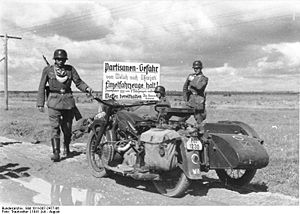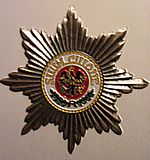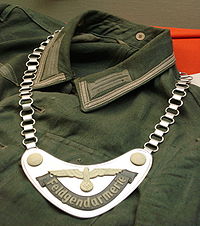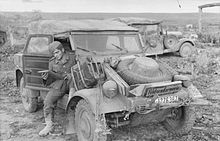- Feldgendarmerie
-
Feldgendarmerie 
Command pennant for a Feldgendarmerie company during World War II.Active 1866 - 1918
1933 - 1945Country  German Empire
German Empire
 Nazi Germany
Nazi GermanyBranch Heer Type Military Police Role Apprehending deserters, border control and anti-partisan duties. Nickname Kettenhunde (English: Chain-dog) Disbanded Nominally May 8, 1945
Completely 1946The Feldgendarmerie (English: Field Gendarmerie [1]) were the uniformed military police units of the armies of the German Empire (including the Wehrmacht) from the mid 19th Century until the conclusion of World War II.
Contents
Early history
Early incarnations of the Feldgendarmerie came into being on an ad-hoc basis through mobilizations of the German army as a whole, most notably in the wars of 1866 and 1870. At the outbreak of the First World War the Feldgendarmerie comprised 33 companies. They each had 60 men and two NCOs. By 1918, the number of companies had been expanded to115 units.
After World War I all military police units were disbanded and no police units existed in the post-war Weimar Republic. Garrison areas were patrolled by regular soldiers functioning as military police.
Nazi Germany
When Adolf Hitler came to power in 1933, Feldgendarmerie were reintroduced into the Wehrmacht. The new units received full infantry training and were given extensive police powers. A military police school was set up at Potsdam, near Berlin to train Feldgendarmerie personnel. Subjects included Criminal code, general and special police powers, reporting duties, passport and identification law, weapons drill, self-defence techniques, criminal police methodology, and general administration.
All prospective candidates served at a Feldgendarmerie command after the first term of examinations. Courses lasted one year and failure rates were high: in 1935 only 89 soldiers graduated from an initial intake of 219 candidates. Feldgendarmerie were employed within army divisions and as self-contained units under the command of an army corps. They often worked in close cooperation with the Geheime Feldpolizei (English: Secret Field Police), district commanders and SS and Police Leaders.
World War II
Operations
 Feldgendarmerie operating in occupied Russia, July 1941. The sign says "Partisan danger ahead. Single vehicles Stop! Hold weapons ready.".
Feldgendarmerie operating in occupied Russia, July 1941. The sign says "Partisan danger ahead. Single vehicles Stop! Hold weapons ready.".
Feldgendarmerie units were generally given occupation duties in territories directly under the control of the Wehrmacht. The duties policing the areas behind the front lines, ranged from straightforward traffic control and population control to suppression and execution of partisans and the apprehension of enemy stragglers.
When combat units moved forward out of a region, the Feldgendarmerie role would formally end as control was then transferred to occupation authorities under the control of the Nazi Party and SS. But Feldgendarmerie units are known to have assisted the SS in committing war crimes in occupied areas. Author Anthony Beevor explores some well-documented cases of their participation in his book Stalingrad.
But by 1943 as the tide of war changed for Nazi Germany, the Feldgendarmerie were given the task to maintain discipline in the Wehrmacht. Many ordinary soldiers deemed to be deserters were summarily executed by Feldgendarmerie units. This earned them the pejorative Kettenhunde (English: chained dogs) after the gorget they wore with their uniforms. The arbitrary and brutal policing of soldiers gave them the other nickname Heldenklauer (English: hero-snatcher) because they screened refugees and hospital transports for potential deserters with orders to kill suspected malingerers. Rear-echelon personnel would also be checked for passes that permitted them to be away from the front.
The Feldgendarmerie also administered the Strafbattalion (English: Penal Battalion) which were Wehrmacht punishment units created for soldiers convicted by court martial and sentenced to a deferred execution. During the final days of the war, as the Third Reich crumbled, recruits or soldiers who committed even the slightest infraction were sent to Strafbatallionen.
The SS-Feldgendarmerie wore the same uniform and gorget as their Heer counterparts but had an addition cuff title indicating they were military police. Generally they conducted the same policing role, such as controlling rear areas but they also conducted counter-insurgency operations with einsatzgruppen against Jews, partisans and those deemed to be "enemies of the Reich". These SS units had a severe reputation for being strict enforcers of military law. Nicknamed Kopf Jäger (Head Hunters), they also tracked down and punished those deemed to be deserters. From 1944 onwards, former members of the Ordnungspolizei serving with the Waffen SS, were also given military police powers and duties. These special SS-Feldgendarmerie were denoted by a diamond polizei-eagle insignia worn on the lower sleeve.
In January 1944 as the Red Army began to advance on the Eastern Front, the power of the Feldgendarmerie was superseded by the creation of the Feldjägerkorps. Answering only to the German High Command (OKW), its three regiments were founded to maintain discipline and military cohesion in all branches of the Wehrmacht (including the Feldgendarmerie). Feldjägers were recruited from decorated, battle-hardened officers and NCOs. They had the military authority of the OKW to arrest and execute officers and soldiers from either the Wehrmacht and the SS for desertion, defeatism and other duty violations.
Despite the surrender of all German forces in May 1945, some Feldgendarmerie and Feldjägerkorps units in the western zones of occupied Germany were allowed to keep their weapons by the Allies because of the number of POWs that required guarding and processing. For example, the British VIII Corps based in Schleswig-Holstein used an entire regiment of volunteers from the Feldgendarmerie to maintain discipline at its demobilisation center at Meldorf. Re-activated military police, who received extra rations as pay, were identified by an armband stating Wehrmachtordnungstruppe (Armed Forces Order Troop). More than 12 months after the official end of the Second World War, the Feldgendarmerie became the last German units to surrender their arms in July 1946.
Organization
The Feldgendarmerie was under the direct control of the German High Command O.K.H (Oberkommando des Heeres). A Feldgendarmerie General Major[who?], who was in charge of all Feldgendarmerie personnel attached to the Wehrmacht, was directly subordinated to the Generalquartiermeister. He was responsible for postings and personal administration, monitoring the performance of the police units, allocation of tasks, traffic regulations and training. His immediate subordinate was a staff officer attached to each Oberkommando Army who commanded the one or more Feldgendarmerie battalions attached to each Wehrmacht formation. The staff officer was responsible for maintaining order and discipline, traffic control during large scale troop movements and maintaining transport routes. Each Feldgendarmerie battalion also had support personnel such as cooks, clerks, and armourers.
A battalion was subdivided into smaller-sized Truppen which were attached to each division or corps. A Gruppe, a section sized unit, were then assigned to specific field or local commands. Feldgendarmerie sections would also be temporarily assigned to special operations, such as anti-partisan duties. A typical Truppe attached to an Infantry or Panzer Division would have up to three officers, 41 NCO's and 20 enlisted men. They would operate in Kübelwagen, trucks and motorcycles (with sidecars).
Equipment
These battalions were equipped with motorcycles and motorcycle combinations which were armed with MG34 machine guns, Kübelwagen, Field cars such as the Horch 4x4 and 3 ton Opel Blitz lorries and a small number of armoured vehicles as a means of transport.
Weapons
Personal weapons consisted of small arms such as the Walther PP which was designed as a civilian police pistol (PP-Police Pistole) or the Walther PPK both of which were favoured by officers whereas the Luger PO8 and Walther P38 were used by other ranks. Automatic machine pistols were carried by NCOs and the Mauser Karabiner 98k rifle was issued but was not widely used. The MG34 and MG42 were used as vehicle mounted armament for defending road blocks or vehicle checkpoints.
Postwar reorganization
 The traditional symbol of the Feldjägers is the Prussian Gardestern Schwarzen Adlerordens (The order of the black eagle) created by Frederick I of Prussia.
The traditional symbol of the Feldjägers is the Prussian Gardestern Schwarzen Adlerordens (The order of the black eagle) created by Frederick I of Prussia.
With the creation of the Bundeswehr in 1955, many of its branches of service were given names that would at least nominally distinguish them from their logical Wehrmacht equivalents. Thus, military police in the modern Bundeswehr were not called Feldgendarmerie. In fact, the original intent was to call the MPs Militärpolizei, literally military police. However, state officials protested as the law enforcement function in the brand new German constitution had been given primarily to the states, not the federation. The word Polizei (Police) was jealously guarded by the states, so the Federal Defence Ministry searched for a new designation and adopted Feldjäger which was a traditional Prussian regiment with some military police type functions.
See also
External links
Notes
- ^ A compound of the native German term Feld, and the word Gendarmerie, imported from Old French: cavalry, from gent d'armes, gendarme, mounted soldier.
Categories:- Defunct law enforcement agencies of Germany
- Military provosts of Germany
- Defunct military provosts
- Defunct gendarmeries
Wikimedia Foundation. 2010.


